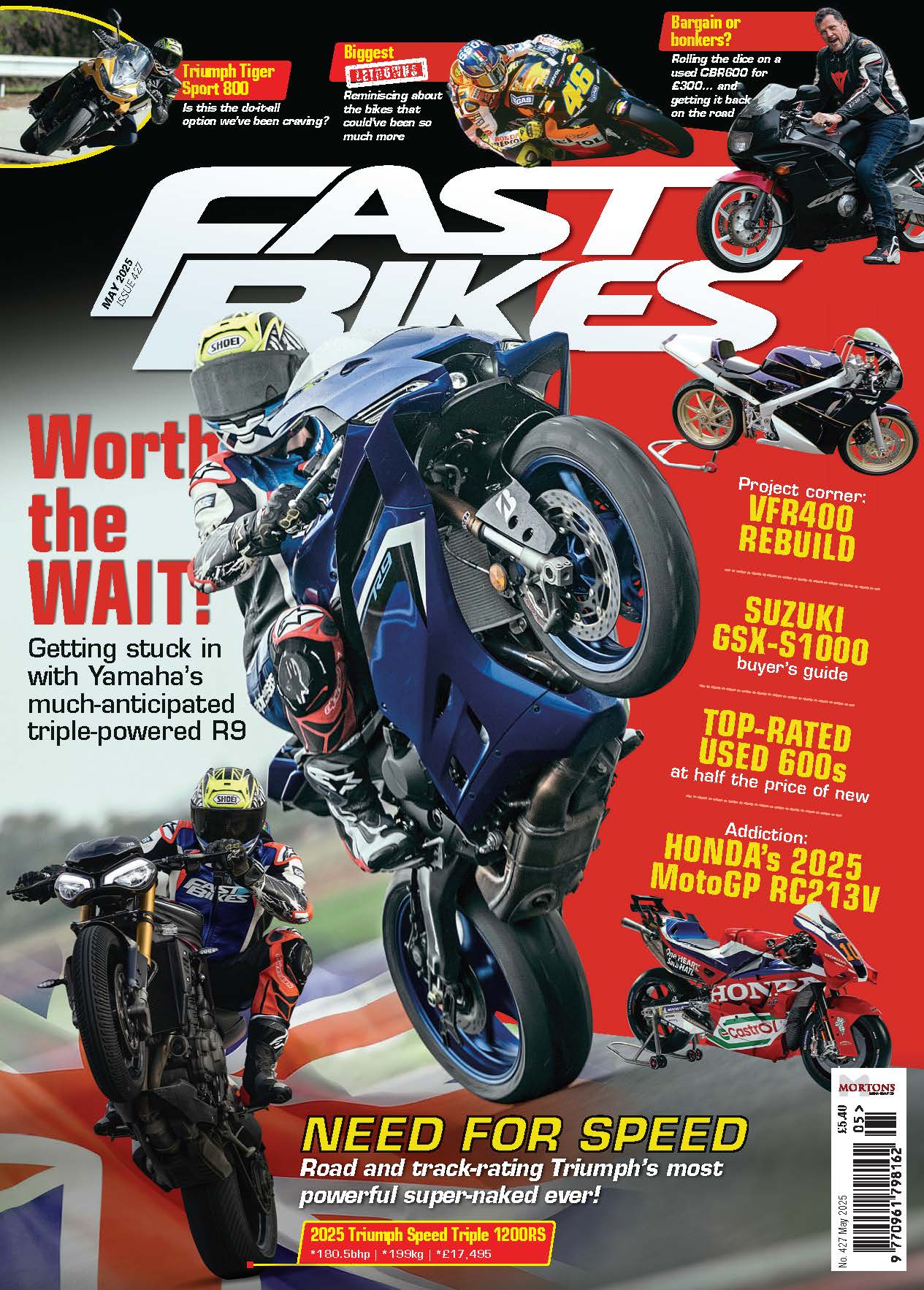Yamaha’s MT-10 requires no introduction, but in more recent times the thing it has needed most is a good and proper upgrade.
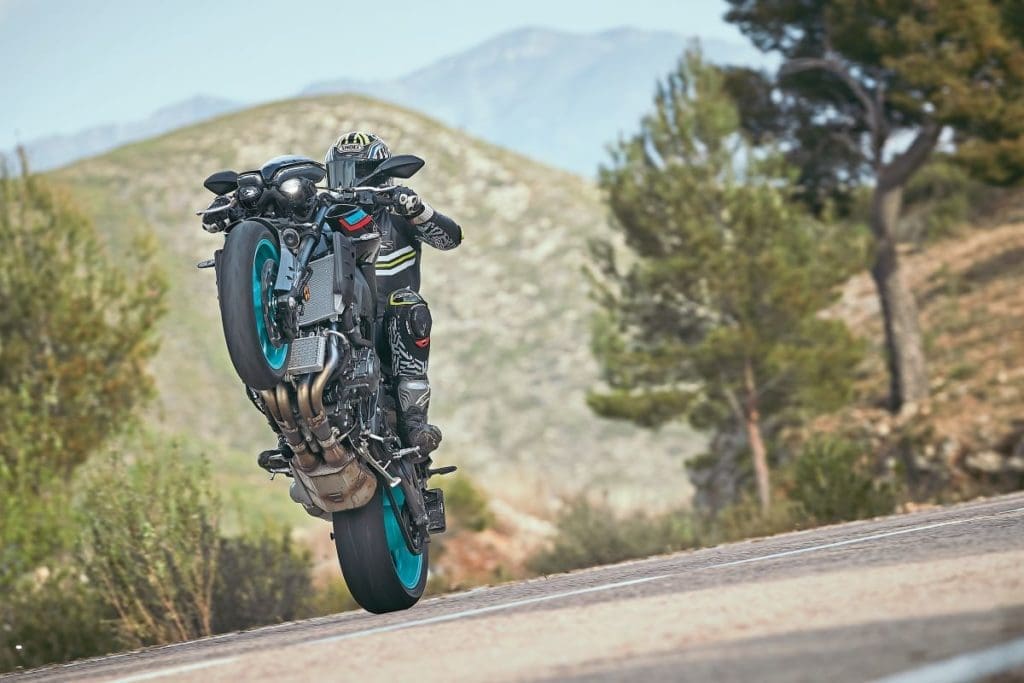
Words> Bruce
Pics> Long-Jon / ANT Productions
It’s hard to believe it was six years ago that the MT-10 came bounding into our lives, kicking down our senses, and making our licences feel as vulnerable as a worm on a fishhook in a pool of piranhas. While its looks might have split opinions more so than Marmite, its unapologetic head-banging formula won over our hearts, souls, and mesmerised minds, delivering to the masses an affordable, outrageous and performance-fuelled wheelie machine, complete with wide ‘bars, a comfy seat and mirrors that showed more than just your hairy armpits. You could say the MT-10 was a pioneering performance for the Japanese brand, arriving on the scene just a year after the 2015 launch of Yamaha’s coveted MotoGP-inspired R1, which became the donor of much of the MT-10’s parts, DNA and excitement. The truth is that the iconic hypernaked we’ve since come to know and love was picking up the pieces from where the MT-01 and FZ1 had tried and failed a decade earlier. Unlike its predecessors and their long lists of limitations, the MT-10 nailed the magic formula, taking the fight to like-minded rivals, such as KTM’s Superduke and BMW’s S1000R. A legend was born… but time takes no prisoners and in recent years the shine has been shed from the brand’s flagship naked, overwhelmed by next-generation competition with more tech, more power and, quite honestly, more appeal. 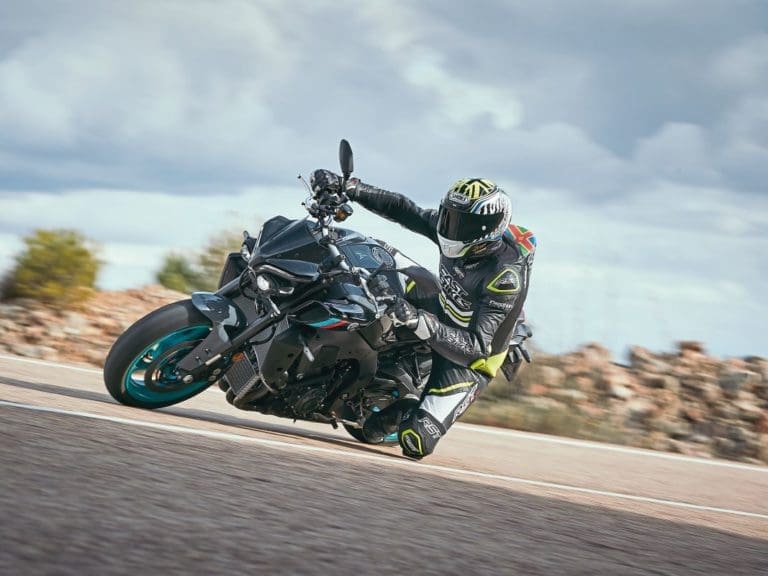 The MT’s more planted than ever.
The MT’s more planted than ever.
When the word got out that Yamaha was set to release a new MT-10 towards the back end of last year, I’ll admit my heart did a few backflips and my mind meandered off into the distance with visions of a ground-up, no-holds-barred hooligan machine, the likes of which we’d never seen before. Surely, that was the right and proper way for Yamaha to evolve the MT story, ensuring the continued success and desirability of a bloodline that has sold a total of 420,000 machines since 2013 (with the arrival of the MT-09), and equates for nearly 50% of the brand’s sales year-on-year. To put it starkly, without the MT family, there probably would be no Yamaha – and they, above all, people know that. So, like many, I was a tad confused and disappointed as my dreams of a box-fresh MT-10 were bludgeoned into the abyss when it transpired that the model was actually getting an ‘update’. Having put my toys back into the pram and taken the time to study the specs of the next-generation renegade, I found some comfort. Quite a lot of comfort, in fact, egged on mainly by the knowledge that the motor’s output had been given a good seeing to, while ticking the boxes to make it Euro5 compliant. If there’s one thing the old bike wasn’t lacking it was torque, but that’s not stopped Yamaha from getting down and dirty with the motor’s low and mid-range characteristics, bolstering both significantly through changes to the fuelling, intake and exhaust systems. At the same time, peak power’s now cranked up to a claimed 165bhp and they’ve even managed to make the bike 15% more fuel efficient. That latter point is significant because one thing that hasn’t changed is the size of the MT’s 17-litre tank, which is prone to running ‘eMpTy’ all too often. It has been slightly restyled though, becoming narrower, in a bid to offer better purchase with the rider’s knees while blending in with the rest of the new bodywork that is now less ‘Transformer’ and more ‘Predator’, thanks to a sleek and menacing new face that features dual LED headlights and indicators, plus sharper styled daytime running lights in the shape of a Y… for obvious reasons. The rear seat unit’s been remodelled also and, thanks to a new subframe, the rider seat height has increased by 10mm to encourage a more front-bias feel to the bike. While the R1-derived chassis is still the same, the bike’s KYB suspension has been reworked at both ends – but the big news is the MT’s now got an IMU… and all the trinkets that come with it. In the year 2022 some things are in excusable, such as mullets, ghetto blasters and cable-operated throttles, and that message has finally hit home on Yamaha’s flagship naked offering. But rather than bolting on some ten-a-penny gismo that came free in a Christmas cracker, the MT’s been treated to a proper six-axis system, meaning rider aids such as wheelie control, slide control, engine braking and cornering ABS are now stock features on the bike, displayed and governed neatly on the models fancy, new 4.2-inch TFT dash. Well, when I say ‘new’, I mean new to it. In reality it’s another hand-me-down from the R1, which is nothing to complain about. During the model’s presentation, in Valencia, the fitment was described as contemporary and simplistic, which pretty much hit the nail on the head. There are much tricker dashes out there but it’s still a vast improvement over what was on the bike before, and the same goes for the operating systems, governed largely via the YRC Menu button/wheel that R1 owners will be very familiar with. Unlike before, you can now programme the characteristics of the MT in countless ways, making the most of an abundance of tech that includes four different power modes.
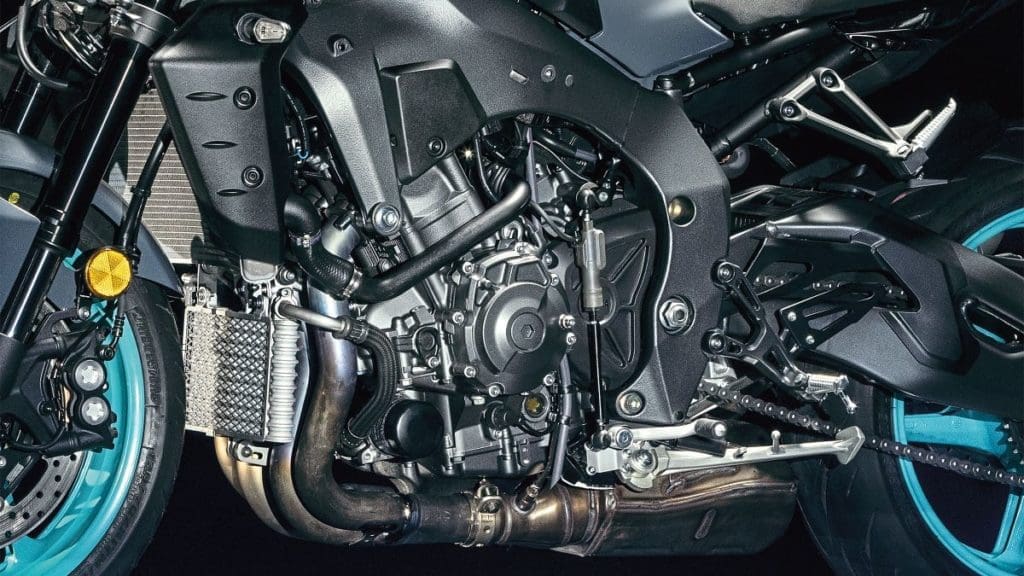
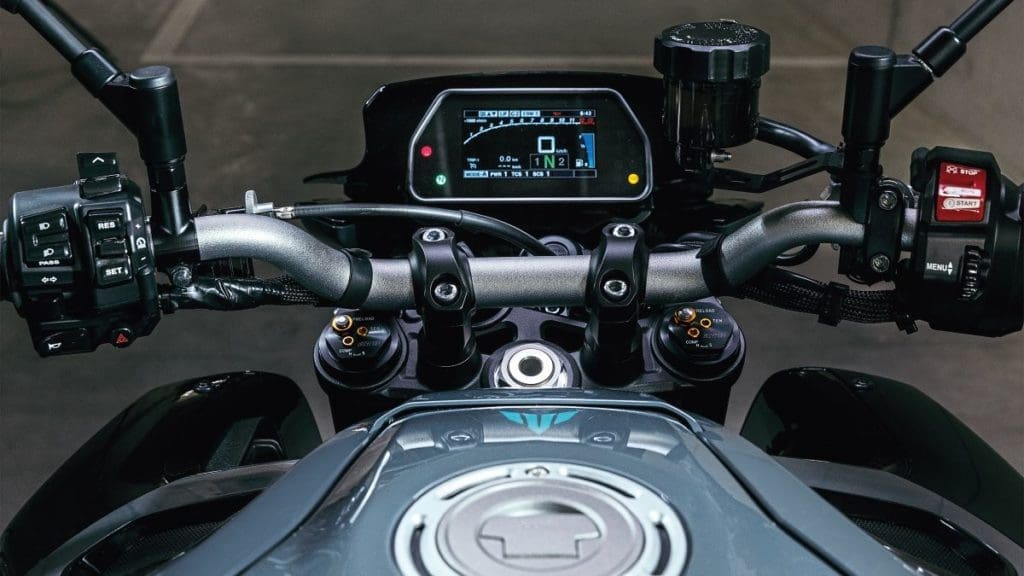
Alternatively, you can select one of four rider modes that predetermine the level of craziness available when you twist on the new ride-by-wire throttle. Add into this smorgasbord of tech the inclusion of a shifter and blipper as standard and you’ll grasp that the MT has finally come of age in the electro-wizardry department. In fact, that was the closing statement during the model’s presentation – that the MT-10 had matured a hell of a lot since its inauguration back in 2016, becoming more refined and sophisticated in 2022… which sounded great in principle but provoked a cold sweat at the thought of this insane, raw and adored specimen being replaced by a ‘sensible’ successor. Surely Yamaha wouldn’t have done that. In a world so politically correct you feel obliged to write a letter of apology every time you sneeze, the MT’s presence has shone bright, reminding us that not everything should be cute, cuddly and/or tree-hugging. It’s loud, proud and whole-hearted characteristics have been a tonic through these dark times and even though the hypernaked’s retina-burning fluro wheels are now a thing of the past, it didn’t take me long on our joyride to realise that, marketing spiel aside, the MT is well and truly still mental… but in a good way.
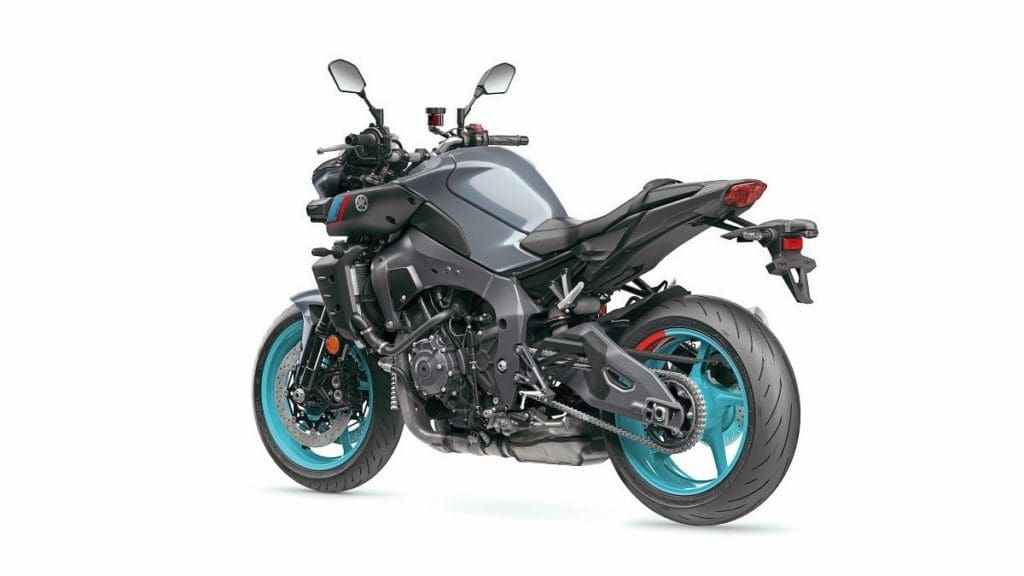
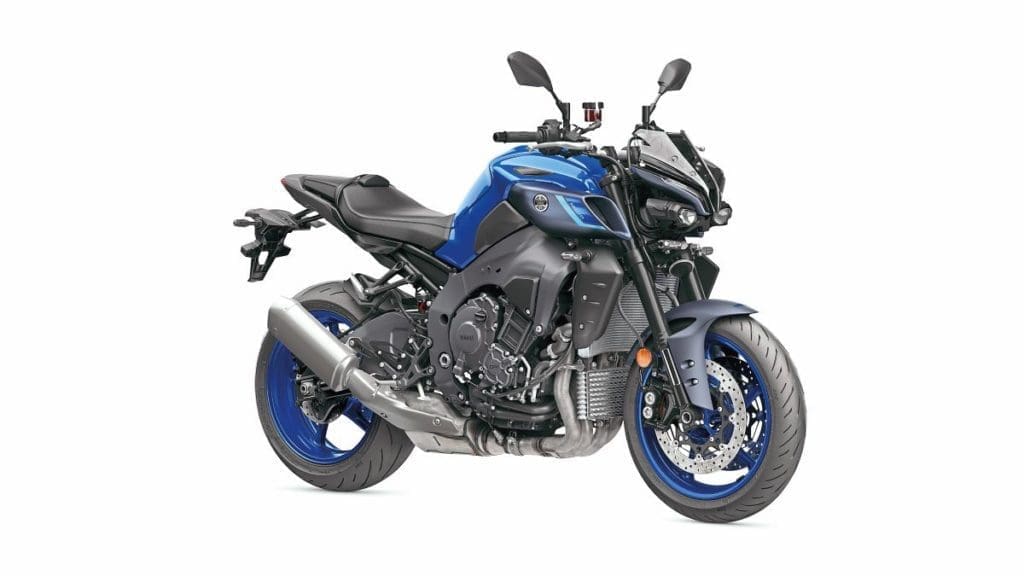
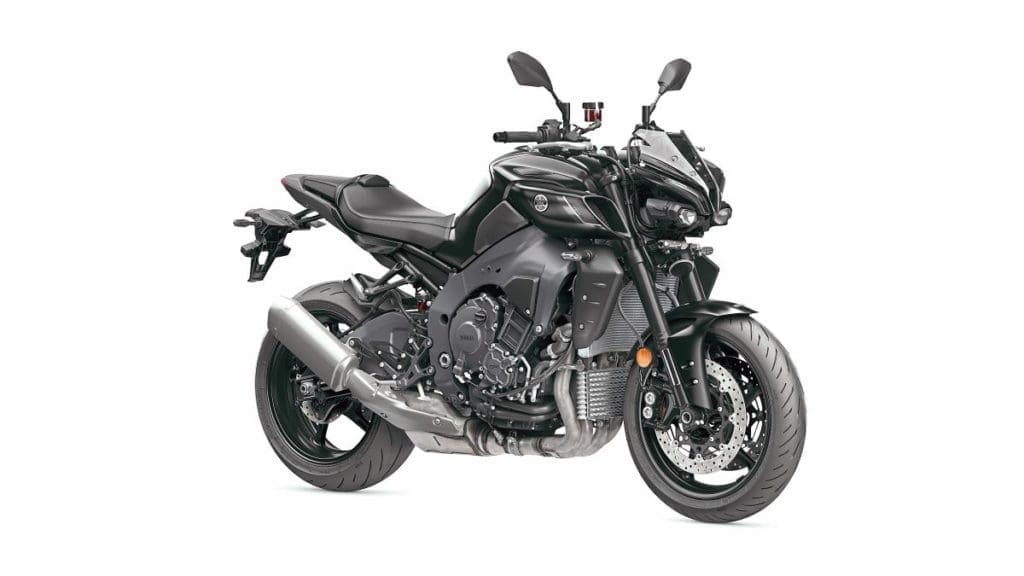
In truth, I was a little bit nervous when our seven-hour soirée eventually got underway, knowing full well that the piss-wet roads we were riding were as grippy as a greased baking tray. Having had plenty of experience on MTs of old, I also knew that the aggressive throttle pick-up on the last model took no prisoners. But this is where the advancement of the new bike came waging in. Yes, it’s got more torque. Yes, it’s got more power… but it’s also now got a throttle that offers feel and precision and doesn’t try to kill you. Within the first few minutes of the ride, tackling roundabouts, urban traffic, and potholes the size of bears, I quickly learned how fluid and forgiving the bike’s pick-up was – words I definitely couldn’t use to describe the old bike’s power delivery. The MT had taken a massive step forward, and even the back-torque created when I shut off was a mere shadow of its former self… much to my liking.
Of course, there’s only so much evaluation you can do in built-up areas and here was a bike that was craving to be unleashed wholesale. Having escaped suburbia and traded it for mountainous switchbacks, my true test of the MT commenced. By this point in time, I was already feeling very comfy on the bike, which had a look and feel much the same as what had come before. Okay, the fancy dash was definitely easier on the eye, and the taller seat did provoke a slightly sportier feel, but otherwise it felt like any MT that had come before; big, spacious and brimming with energy. It did, however, feel more planted than the last bike. I’d hold back from saying more agile, especially considering the new model’s actually gained a few kg over the last one, but it was more sure-footed than I remembered, mopping up road imperfections with ease and offering a reassuring level of feel on the damp squiggles of tarmac we were consuming. As slippy as the road surface was, the Bridgestone S22s fitted proved the perfect sparring partner for the conditions and meant that big handfuls of power could still be asked for without too much drama. That said, I soon learned that switching the power mode to level two from one (the spiciest) gave a nicer and better-suited delivery for the conditions without spoiling the party. Level three was a little lagging for my liking and level four didn’t even warrant a place on the bike. I should point out that I was able to change all this on the go, along with the traction control level and slide control, too. To turn off traction altogether meant having the bike stopped, and switching the wheelie control off completely meant going into the YRC Menu and disengaging the system. I did the first part of the ride with the bike in level three of the LIF control (least wheelie intervention) but figured the ride would be a whole lot more fun with free-rein wheelie potential at every given opportunity, so I dialled that out the minute we stopped for a brew.
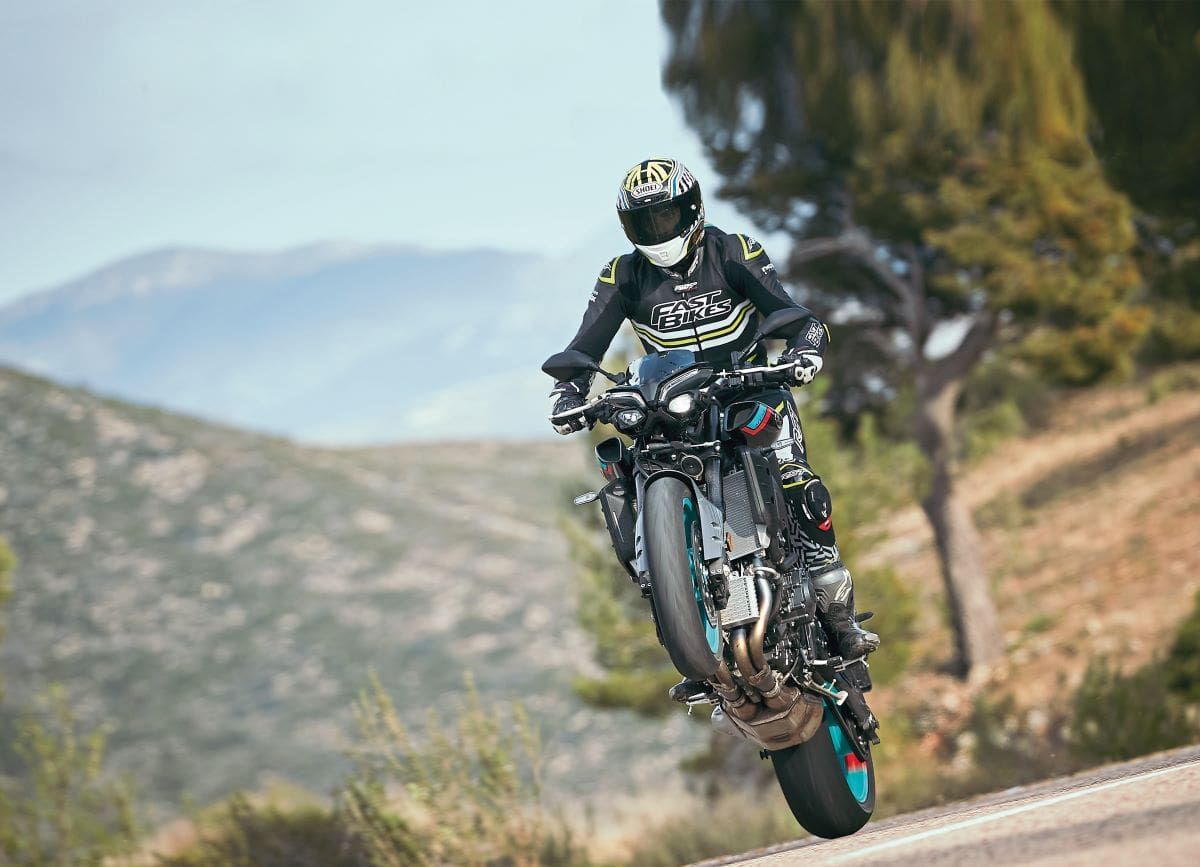 Stand up if you like wheelies…
Stand up if you like wheelies…
As fun as the ride was, the damp roads were holding me back akin to an alcoholic in a booze-free bar. Here was a bike with a truly menacing motor that I was craving to wring the neck off, but the conditions just didn’t allow it. A few times I did get a little greedy with the throttle and the bike’s traction control system had to step in and save the day. I was also grateful of the new cornering ABS feature that I got to test in the bends on more than one occasion, squeezing a bit too hard on the new Brembo mastercylinder that offers so much more feel than the old bike’s unit. As much as I detested the conditions, I was getting an insight into the bike that I probably wouldn’t have had if the route was bone-dry. The farther we went, the more I came to appreciate the package beneath me, acknowledging the gains that Yamaha had made over the first version of MT. It was so much more ridable and pliable than its predecessor, but without compromising excitement or presence. In fact, thanks to the new intake system and its ‘acoustic grilles’, the ’22 spec sounded meatier on the throttle and there were no complaints on my part about the exhaust note pinging out from the R1-styled titanium exhaust system either.
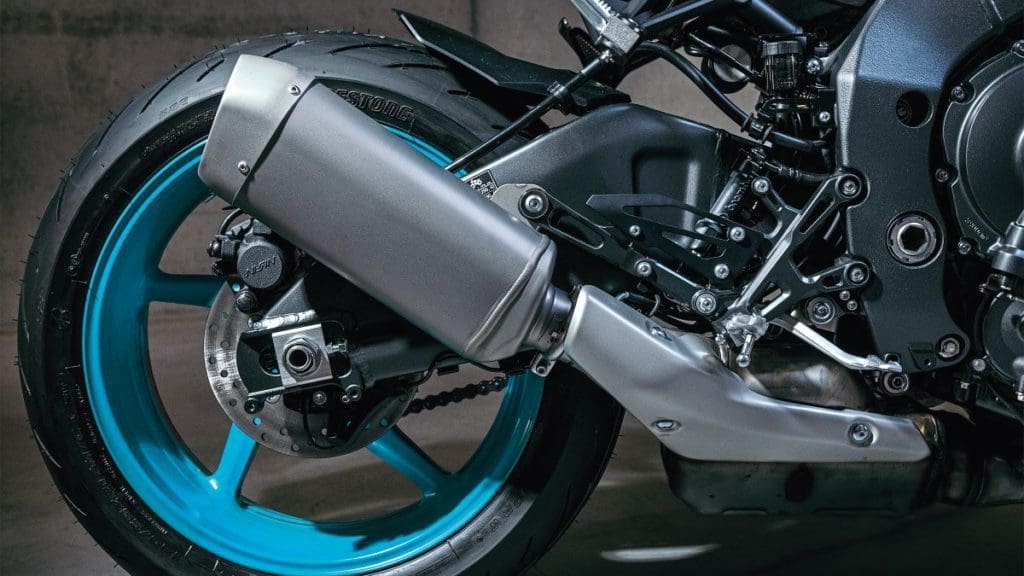

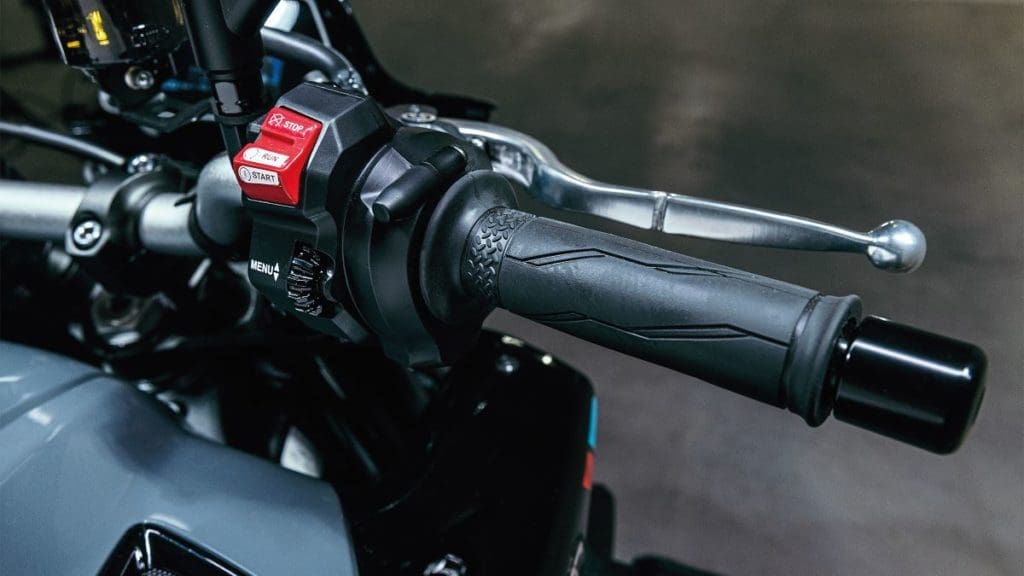
This bike was growing on me for all the right reasons, and that adoration got raised to a whole new level in the last hour of our ride. Without warning the roads turned dry, the sun came out to play, and my MT was subjected to a level of abuse it had yet to experience in its young and tender life. There is nothing more playful than a crossplane motor being thrashed in every gear and egged on by a silky smooth shifter; I was in my element. At last I was getting the full-blown experience of how brilliant this motor was, sampling firsthand the potency of the new mid-range that meant wheelies were compulsory in the first three gears, and a dab of the clutch was all it took to get the front lofted in fourth and fifth. As already mentioned, I’d been a little disappointed at first when hearing there was nothing overly elaborate about the new MT-10, but such musings vanished into thin air after this extravaganza. The Yamaha might be 50bhp down on some of its rivals, but that didn’t feel the case when trying to tame this beast that, in turn, was trying to bring out the brute in me. The power on tap was awesome, clinically smooth and linear in its delivery, without a hint of hesitation from the fuelling. The gearbox was great, the blipper worked a treat, and slipper helped absorb anything I threw at it. Best of all, the non-switchable ABS soon threw up a white flag the minute I started introducing burn-outs into the situation, which in turn meant skids were on the card and I was able to appreciate the stopping power of the rear brake without the ABS sending the system into a spasm. For the best part of two hours, using a closed road as a stunt park, I had an absolute blast and remembered what it was to love an MT-10. The ride back to our hotel in Valencia was bitter-sweet, knowing soon that this experience would be over, but simultaneously grateful that I’d had the chance to put this machine through its paces.
Yamaha’s not gone for headlines with this bike. The brand’s not tried to sensationalise the experience with novel bolt-ons and pricey parts that arguably look good but render the bike inaccessible to the likes of its loyal fanbase that have made this machine a bestseller on a global level. Yamaha has wisely chosen to take what it had, make it better in just about every single way, and line it up in showrooms – fully-kitted with contemporary tech – for £13,300… a price that puts it among the most spec’d, competent and affordable of machines in the hypernaked sector. And that’s exactly the reason this legend is set to live on.
Verdict: 8/10
Yamaha’s built on the MT’s firm foundations, redefining the potency and performance of this all-out hypernaked with the kind of smart tech and qualities it needed to stay in the mix among its rivals.
+Cracking motor, sounds amazing
– Not the ground-up build we’d hoped for
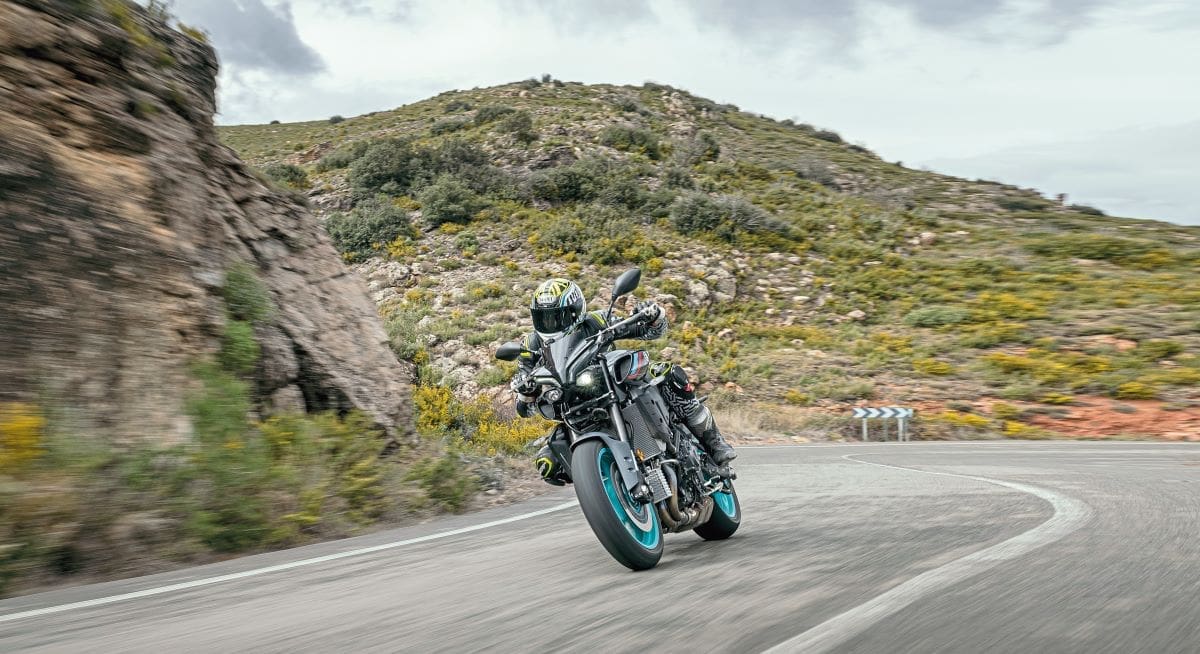 The MT’s back in the game.
The MT’s back in the game.
Word from the top…
In a bid to grasp the rationale behind the MT’s evolution, we sat down for a beer with Yamaha’s product planner, James McCombe.
Have you done enough for the new MT to be competitive?
The whole sector has changed radically in the last few years. There are now plenty of hypernakeds with in excess of 170-200bhp, but a big horsepower figure was never a key objective for this bike; the question was how we could make this the most fun possible to ride on the road. Although we increased the power up to 165bhp, that was not a specific objective. The aim was to keep the character and the fun, and maintain the value factor as well. We could have slotted in an R1 engine but that would have meant the cost of the bike rising considerably. As already mentioned, there are much more powerful bikes in this sector, and there are some that aren’t so different. The great thing about this sector is there are many different ways to butter your bread.
Is the MT-09 now stepping on the MT-10’s toes?
That’s a good question. We’ve evolved the MT-09 heavily and I’ll admit that after riding the latest version for the first time, I did question who’s now going to be the customer for the MT-10. But when you ride them back-to-back, the engine performance is on another level, and the chassis feel and performance is something else. The bottom line is there’s still a significant step between the two models – and we see the target audience being different, too. The MT-10 is there for those really experienced riders who want big performance and no compromise.
Who and what shaped the new MT-10?
Well, firstly, legislation meant we had to get stuck in and change the motor to make the bike Euro5, and while we were at it we realised there was plenty of scope to make the motor better. One of the biggest complaints we had about the previous generation bike was its efficiency; it was too thirsty, so we saw a big opportunity to get address this area, while improving the fuelling performance at the same time. Typically, it’s very difficult to get more power and fuel economy but we managed both. Other key changes were influenced by what we were seeing in the market, prompting us to freshen up the look of the bike and give it a much-needed rework of the electronics. Rider aids are super important nowadays to allow any calibre of rider to get the most of the bike. It was obvious that there was some frustration from customers that we weren’t facilitating the same level of tech as rivals on the market, so we addressed that issue head-on.
Should you have gone further?
Of course, it’s super easy to go down the list of offerings from our engineers, adding lightweight items and go-go items, especially on the electronic side, but it might not have been for the best. It’s not that we were building the MT to a cost, but more so that we were crafting a bike to a target price that we know our customers want. Adding loads of other functions might not have translated to more sales; we want to keep the model accessible. It’s difficult to believe we’d have had the same degree of success if we’d loaded the MT-10 up and cranked the price accordingly. The MT has always been a value proposition, right from the outset with the MT-07 and MT-09. What people got were great riding machines at great value, and that ethos carries through to today and is the main focus of what an MT is. We know there are many people out there who want the most characterful riding experience they can get and that’s their primary point that they’re looking for on a bike – anything else is additional. Whether they want to pay for that, that’s up to them, so we offer the SP for the bling, but as for the standard models in the MT range, the key focus is value.


